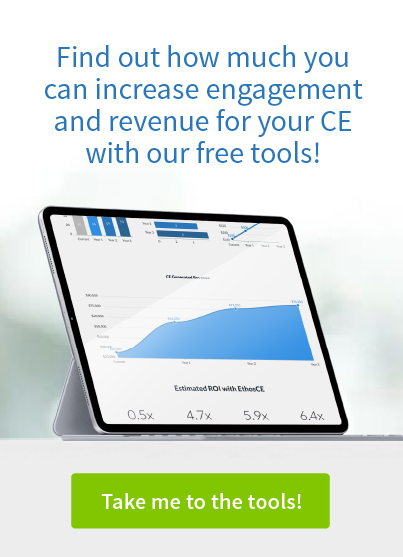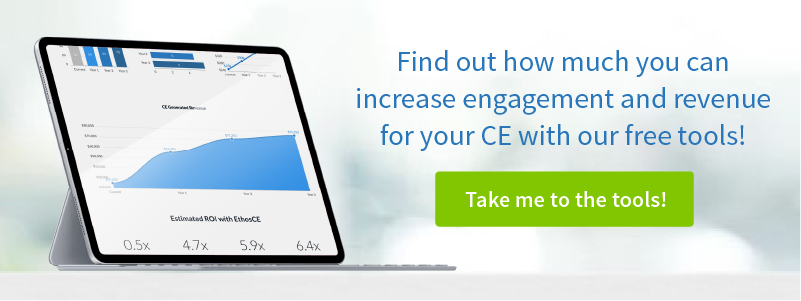Best Practices for Online Faculty Development: A CME Director’s View
Patricia Stubenberg, MPH, PhD, CHCP is the Director of Continuing Medical Education and Preceptor Development at the Lincoln Memorial University-DeBusk College of Osteopathic Medicine in Harrogate, Tennessee.
Patricia is a long-time EthosCE customer, and I recently had the pleasure of working with her on her platform upgrade. After seeing the LMU-DCOM programs I wanted to learn more and asked her to sit for an interview for the EthosCE blog.
Q. Tell us about your role at LMU-DCOM.
There are two parts to my job at LMU-DCOM. One is CME where I handle all the continuing medical education programs — from accreditation rules and requirements to developing and facilitating live and online CME programs.
The second role is preceptor development. I facilitate the development of training programs for clinical teachers of our medical students, primarily in the third- and fourth-year rotations.
Q. Where does LMU-DCOM fit in the world of continuing medical education?
Our mission is primary-care focused. Because of our rural and geographic locations our medical education includes a distributed model campus where clinical training is delivered to better meet primary care needs and expectations.
While there are ample opportunities for clinical teaching and faculty development within an academic teaching institution, our difficulty is reaching our geographically dispersed rural preceptors and clinical faculty. They may not have access to faculty development programs in an academic institution or teaching hospital. Our distance-based education, through our online CME platform, can help us achieve that goal.
Q. How are you delivering AOA Category 1-A credit in a distributed online education model in rural environments?
 Patricia Stubenberg, MPH, PhD, CHCP is the Director of Continuing Medical Education and Preceptor Development at the Lincoln Memorial University-DeBusk College of Osteopathic Medicine
Patricia Stubenberg, MPH, PhD, CHCP is the Director of Continuing Medical Education and Preceptor Development at the Lincoln Memorial University-DeBusk College of Osteopathic MedicineThat is one of our challenges. Since Category 1-A, AOA credit applies primarily to live events and interactive webinars, we have to be creative and make online category 1-B activities instructionally effective and bring in best practices in learning and instructional technology.
For example, we try to incorporate assessments and reinforcement throughout online modules. So you’re not going through the module wondering what’s going to be on the post-test, but instead you get questions that reinforce learning during the module.
Q. What kind of feedback do you get on the online modules versus live activities?
We do needs assessments and surveys to keep track of what the needs and practice gaps are among our clinical teachers. And many times, they indicate that the best way for them to get CMEs is to do so at their convenience, late at night or on their lunch hour. The interactive webinars are still important, but we do find a majority of the feedback indicates that the online, at-your-convenience version is very important to them. The online modules also provide feedback through course evaluations.
That’s our focus with online faculty development. I believe there’s a huge need for it. You see a lot of programs geared for full-time faculty at an academic institution, but you don’t see a lot of training for the preceptor or the adjunct faculty who are teaching the third- and fourth-year medical students and that also offer CMEs.
Q. How does the distributed and rural faculty change the techniques you use to do needs assessments?
Annual and intermediate needs assessments, within our clinical teaching arena are conducted to make sure we’re on track. But it’s not just the assessment. There’s more involved, for example, looking at the health data in the local area where our faculty are located. The peer-reviewed literature is becoming very helpful in developing and facilitating the program development for faculty in rural areas.
Q. How does a preceptor find your CME activities?
We have about 22 clinical core sites in the Tennessee and surrounding states including Kentucky, Arkansas, and Virginia. We do site visits several times a year. Those visits often include a clinical training component that helps promote the training for the preceptors. CME announcements for live and online programs are distributed throughout the year.
Q. Tell me about the business operations of the CME office.
The long-term goal of this office is to become self-sustaining. It’s challenging, but it’s absolutely rewarding for me to move in that direction because I’ve learned a whole lot from it.
We’re in a geographical location that is difficult to get attendees. We’re an hour away from a larger city. So we use the online system to share our wealth of CME and clinical teaching knowledge. We’re also a relatively new academic institution so we use word of mouth and site visits to help market programs.
One of our goals within the office is to not only reach our own clinical teaching faculty, but also other healthcare professionals locally, regionally and nationally as experts in best practices in clinical teaching, especially in the distance learning environment and rural population.
Q. Are there particular things you try to do from a marketing or content perspective that makes the activities more appealing or more relevant than your online competitors?
You can pretty much go anywhere to find a live or online CME module that’s going to meet your needs, so we focus on faculty development for clinical teachers and CME programs with the rural practitioner in mind.
For example, “ENT for the Primary Care Practitioner,” is a live event co-sponsored with an ENT practice group in Knoxville. They’re providing a lot of the content expertise and then we combine it with the osteopathic primary care model. We’ve found a niche with the online preceptor development as well.
Q. How does osteopathic medicine factor into marketing your activities?
We have found a large population from California of osteopathic physicians who are taking the online courses. What I found is that California has ample CME programs, but they’re not really geared for the osteopathic physician (D.O).
Interestingly, a good majority of our preceptors who do teach our third- and fourth-year students are M.D.s rather than D.O.s. So we have to address that population as well. We offer important AMA PRA Category 1™ credit by working with other medical schools.
Q. Tell me about the process of implementing the distance learning approach.
It’s interesting because getting this online program up was a challenge for me. I had little technology background. So, the e-commerce online platform was a challenge at first but, I love it. I’ve become very attached to it, and I think there’s incredible opportunity with it. It was challenging at the beginning, but now it’s like, “Oh all these ideas are rolling around in my head on what I want to do” at a higher level of academic research and clinical teaching.
 We're now part of the Cadmium product suite! Learn more
We're now part of the Cadmium product suite! Learn more 

